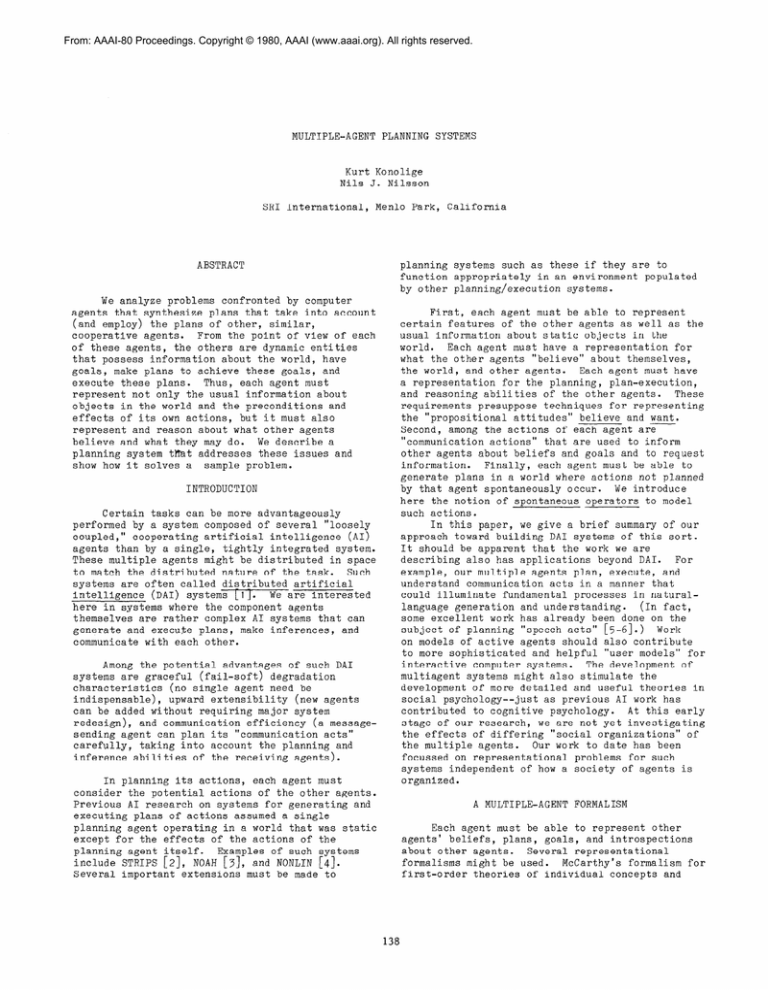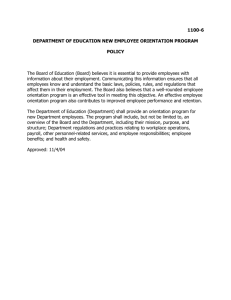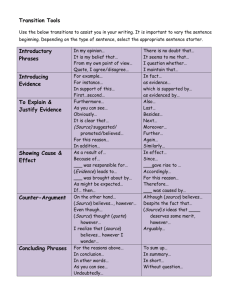
From: AAAI-80 Proceedings. Copyright © 1980, AAAI (www.aaai.org). All rights reserved.
MULTIPLE-AGENT
PLANNING
SYSTEMS
Kurt Konolige
Nils J. Nilsson
SRI International,
ABSTRACT
We analyze problems confronted by computer
agents that synthesize plans that take into account
(and employ) the plans of other, similar,
cooperative
agents.
From the point of view of each
of these agents, the others are dynamic entities
that possess information about the world, have
goals, make plans to achieve these goals, and
execute these plans.
Thus, each agent must
represent not only the usual information about
objects in the world and the preconditions
and
effects of its own actions, but it must also
represent and reason about what other agents
We describe a
believe and what they may do.
planning system t??at address es these is sues and
show how it solves a sample problem .
INTRODUCTION
Certain tasks can be more advantageously
performed by a system composed of several "loosely
(AI)
coupled," cooperating artificial intelligence
agents than by a single, tightly integrated system.
These multiple agents might be distributed in space
Such
to match the distributed nature of the task.
systems are often called distributed artificial
intelligence
(DAI) systems Ll]. We are interested
here in systems where the component agents
themselves are rather complex AI systems that can
generate and execute plans, make infe rences, and
communicate with each other.
Among the poten tial advantages of such DA1
systems are graceful (fail-soft) degradation
characteristics
(no single agent need be
upward extensibi lity (new agents
indispensable),
can be added without requiring major system
redesign), and communication
efficiency
(a messagesending agent can plan its "communication
acts"
carefully, taking into account the planning and
inference abilities of the receiving agents).
In planning its actions, each agent must
consider the potential actions of the other agents.
Previous AI research on systems for generating and
executing plans of actions assumed a single
planning agent operating in a world that was static
except for the effects of the actions of the
planning agent itself.
Examples of such systems
include STRIPS [2], NOAH [S], and NONLIN [4].
Several important extensions must be made to
Menlo
Park,
planning
function
by other
California
systems such as these if they are to
appropriately
in an environment
populated
planning/execution
systems.
First, each agent must be able to represent
certain features of the other agents as well as the
usual information about static objects in the
world.
Each agent must have a representation
for
what the other agents "believe" about themselves,
the world, and other agents.
Each agent must have
a representation
for the planning, plan-execution,
and reasoning abilities of the other agents.
These
requirements presuppose techniques for representing
the "propositional
attitudes" believe and want.
Second, among the actions of each agent are
~communication
actions" that are used to inform
other agents about beliefs and goals and to request
information.
Finally, each agent must be able to
generate plans in a world where actions not planned
by that agent spontaneously
occur.
We introduce
here the notion of spontaneous operators to model
such actions.
In this paper, we give a brief summary of our
approach toward building DA1 systems of this sort.
It should be apparent that the work we are
describing also has applications
beyond DAI.
For
example, our multiple agents plan, execute, and
understand communication
acts in a manner that
could illuminate fundamental processes in naturallanguage generation and understanding.
(In fact,
some excellent work has already been done on the
subject of planning "speech acts" [5-61.)
Work
on models of active agents should also contribute
to more sophisticated
and helpful "user models" for
interactive
computer systems.
The development of
multiagent systems might also stimulate the
development of more detailed and useful theories in
social psychology--just
as previous AI work has
contributed
to cognitive psychology.
At this early
stage of our research, we are not yet investigating
the effects of differing "social organizations"
of
the multiple agents.
Our work to date has been
focussed on representational
problems for such
systems independent of how a society of agents is
organized.
A MULTIPLE-AGENT
FORMALISM
Each agent must be able to represent other
agents' beliefs, plans, goals, and introspections
about other agents.
Several representational
formalisms might be used.
McCarthy's formalism for
first-order theories of individual concepts and
although
propositions
[7] is one possibility,
certain problems involving quantified expressions
in that formalism have not yet been fully worked
out.
Another candidate is Moore's first-order
axiomatization
of the possible world semantics for
the modal logic of knowledge and action [8-g].
Appelt [lo] h as implemented a system called KAMP
that uses Moore's approach for generating and
reasoning about plans involving two agents.
We
find Moore's technique somewhat unintuitive,
and it
seems needlessly complex when used in reasoning
about ordinary (nonattitudinal)
propositions.
Here
we develop a representation
for each agent based on
Weyhrauch's
notion of multiple first-order
theories
and metatheories
[ll].
Using Weyhrauch's
termi nology, each computer
individual is defined by the combination of a
first-order
language, a - simulation structure or
partial model for that language, a set of Facts
(expressed in the language), and a Goal Structure
that represents a goal for the agent and a plan for
achieving it. We assume that each agent has a
deductive system (a combination of a theorem-prover
and attached procedures defined by the simulation
structure) used for deriving new facts from the
initial set and for attempting to determine whether
goals and subgoals follow from the set of facts.
Each agent is also assumed to have a planning
system (such as STRIPS) for creating plans to
achieve goals.
Using a typical "blocks-world"
example, we
diagram an agent's structure in the following way:
Al (agent's
name):
Facts
-----
Goal
--s-e
HOLDING(Al,A)
CLEAR(B)
HOLDING(Al,B)
Viewed as a computational
entity, an agent's
structure is typically not static.
Its deductive
and sensory processes may expand its set of facts,
or its planning system may create a plan to achieve
a goal.
Also, once a plan exists for achieving a
goal, the agent interacts with its environment by
executing its plan.
In this summary, we deal only with the
planning processes of agents.
In the example
above, the occurrence of the goal HOLDING(Al,B)
in
Al's goal structure triggers the computation of a
plan to achieve it. Once generated, this plan is
represented
in the goal structure of agent Al as
follows:
Al:
Goal
m---w
Facts
--w-e
HOLDING(Al,A)
CLEAR(B)
HOLDING(Al,B)
pickup(Al,B)
A
HANDEMPTY(A1)
CLEAR(B)
putdown(A1,A)
/
HOLDIiG(Al,A)
Plans are represented by goal/subgoal
trees
composed of planning operators and their
preconditions.
We assume a depth-first ordering
the operators in the plan.
of
Now let us introduce another agent, AO.
Agent
A0 can have the same sort of structure as Al,
including its own first-order language, a
description of the world by wffs in that language
(facts), a simulation structure, a goal structure,
and a planner and deducer.
Some of AO's facts are
descriptions
of Al's structure and processes.
By
making inferences from these facts, A0 can reason
about the planning and deductive activities of Al
and thus take Al into account in forming its own
plans.
Also, a structure similar to Al's actual
structure, and procedures similar to Al's deducer
and planner, can be used as components of AO's
simulation structure.
Procedural attachment to
these "models" of Al can often be employed as an
alternative method of reasoning about Al.
(Of
course, A0 may have an incomplete or inaccurate
model of Al.)
Because Al's structure is a first-order
language (augmented by certain other structures),
A0 can use a formal metalanguage
to describe it
along the lines suggested, for example, by Kleene
[12] and developed in FOL by Weyhrauch [Ill.
A0
has terms for any sentence that can occur in Al's
language or for any of Al's goals or plans; the
predicates FACT and GOAL are used to assert that
some sentences are in Al's Facts list or goal
structure.
Consider the following example: assume
A0 is holding block A, block B is clear, and A0
believes these facts and further believes that Al
believes A0 is holding A and that Al believes B is
not clear.
A0 would have the following structure:
AO:
Facts
----HOLDING(AO,A)
CLEAR(B)
;;;;;;;,'HOLDING(AO,A)')
/-CLEAR(B) '>
We use quote marks to delimit strings, which
may have embedded string variables.
The denotation
of a ground string is the string itself.
Thus, the
intended interpretation
of FACT(Al,'HOLDING(AO,A)')
is that the wff HOLDING(AO,A)
is part of the facts
139
list of Al (that is, Al "believes" that A0 is
By using the FACT predicate and terms
holding A).
denoting other agents and wffs, any facts list for
other agents can be described.
(A0 can describe
its own beliefs in the same manner.)
We purposely use "believe" instead of "know"
because we are particularly
interested in
situations where agents may be mistaken in their
representation
of the world and other agents.
In
the above example, AO's opinions about its own and
Al's belief about whether or not block B is clear
are inconsistent.
We avoid formalizing
"know" and
thus do not take a position about the relationship
between knowledge and belief (such as "knowledge is
justified true belief").
We can describe some of
the usual properties of belief by axioms like
FACT(x,p) => FACT(x,'FACT(x,p)');
i.e., if an agent
believes p, it believes that it believes p. We do
not, however, use an axiom to the effect that
agents believe the logical consequences
of their
beliefs, because we want to admit the possibility
that different agents use different procedures for
making inferences.
In particular, we want to
emphasize that the deductive capabilities
of all
agents are limited.
While the static structure of Al is described,
for AO, by FACT and GOAL predicates, the action of
Al's deductive system and planner can also be
axiomatized
(for AO) at the metalevel (see Kowalski
[13] for an example).
This axiomatization
allows
A0 to simulate Al's deducer or planner by purely
syntactic theorem-proving.
Thus A0 might use
predicates such as ISPROOFfx,p)
and ISPLAN(x,p) to
make assertions about whether certain proof or plan
structures are proofs or plans for other agents (or
for itself).
In certain cases, A0 can find out if Al can
deduce a particular theorem (or if Al can create a
plan) by running its procedural model of Al's
deducer (or planner) directly, rather than by
This is accomplished
reasoning with its own facts.
by semantic attachments of models of Al's deducer
and planner to the predicates ISPROOF and ISPLAN in
AO's metalanguage.
Semantic attachment thus allows
A0 to "think like Al" by directly executing its
model of Al's planner and deducer.
(Here, we
follow an approach pioneered by Weyhrauch [ll] in
his FOL system of using semantic attachments
to
data structures and programs in partial models.)
The same kind of attachment strategy can be used to
enable A0 to reason about its own planning
abilities.
The usual problems associated with formalizing
propositional
attitudes [8,14] can be handled
nicely using the FACT predicate.
For example, the
atomic formula FACT(Al,'CLEAR(A)
v CLEAR(B)')
asserts the proposition
that Al believes that A is
clear or B is clear, and is not confused with the
v
formula [FACT(A~,'CLEAR(B)')
FACT(Al,'CLEAR(A)')],
which asserts the different
proposition
that Al believes that A is clear or Al
believes that B is clear.
Furthermore,
semantic
attachment methods confer the advantages of the socalled "data base approach" [8] when appropriate.
Of particular importance among statements
concerning AO's beliefs about Al are those that
involve "quantifying
in," i.e., where a quantified
variable appears inside the term of a FACT
predicate.
We follow the general approach of
For example, the
Kaplan [15] toward this topic.
sentence (Ex)FAOT(A~,'H~LDING(A~,X)')
occurring
among AO's facts asserts that Al is holding an
identified (for Al) block without identifying
it
(for AO).
AN EXAMPLE
We can illustrate some of the ideas we are
Suppose that there
exploring by a short example.
are two agents, A0 and Al, each equipped with a
Initially Al is holding a
hand for holding blocks.
block, A, and A0 wants to be holding A. Suppose
that A0 believes these initial facts, but (to make
our example more interesting)
A0 has no information
about whether or not Al itself believes it is
holding A. Thus, the initial structure for A0 is:
AO:
Facts
-----HANDEMPTY(A0)
HOLDING(Al,A)
Goal
me--HOLDING(AO,A)
Let us assume the following planning operators
We use standard STRIPS
(for both A0 and Al).
notation [16].
('P&D' denotes the precondition
and
delete lists; 'A' denotes the add list.)
putdown(x,b)
agent x puts
block b on the table
P&D:
HOLDING(x,b)
A:
ONTABLE
& CLEAR(b) & HANDEMPTY
agent x picks
pickup(x,b)
P&D:
CLEAR(b) & HANDEMPTY
A: HOLDING(x,b)
asktoachieve(x,y,g)
P: T
A: GOAL(y,g)
agent
tell(x,y,s)
P: FACT(x,s)
A: FACT(y,s)
up block
b
agent x gives agent y the
goal denoted by string g
x tells agent y the
expression denoted by string
s
Agents take into account the possible actions
of other agents by assuming that other agents
generate and execute plans to achieve their goals.
The action of another agent generating and
executing a plan is modelled by a "spontaneous
A spontaneous operator is like an
operator."
ordinary planning operator except that whenever its
preconditions
are satisfied, the action
corresponding
to it is presumed automatically
executed.
Thus, by planning to achieve the
preconditions
of a spontaneous
operator, a planning
agent can incorporate such an operator into its
plan.
Let us assume that agent A0 can use the
operator "achieve" as a spontaneous
operator that
models the action of another agent generating and
executing a plan:
agent x achieves goal g by creating
and executing a plan to achieve g.
PC:
GOAL(x,g) & ISPLAN(x,p,g,x)
& ISPLAN(x,p,g,AO)
D: **the delete list is computed
from the plan, p**
A:
FACT(x,g)
FACT(AO,g)
achieve(x,g)
REFERENCES
The expression ISPLAN(x,p,g,f)
is intended to
mean that there is a plan p, to achieve goal g,
using agent x‘s planner, with facts belonging to
agent f. Our precondition
for achieve ensures that
before A0 can assume that condition g will be
spontaneously
achieved by agent x, A0 has to prove
both that agent x can generate a plan from its own
facts and that agent x could generate a plan from
AO's facts (to ensure that the plan is valid as far
as A0 is concerned).
Here
are some axioms
about
ISPLAN
2)
Sacerdoti, E. D., "What Language Understanding
Research Suggests about Distributed Artificial
Sensor Nets,
IntelligenceT,, in Distributed
ppm 8-11. Paper presented at the DARPA
Workshop, Carnegie-Mellon
University,
Pittsburgh,
Pennsylvania
(December 7-8, 1978).
2.
Fikes, R. E. and N. J. Nilsson, "STRIPS: A New
Approach to the Application
of Theorem Proving
to Problem Solving,,, Artificial Intelligence,
2(3/4), pp. 189-208 (1971).
3.
Sacerdoti, E. D., A Structure for Plans
Behavior, (New York: Elsevier, 197r
4.
Tate, A., "Generating Project
IJCAI-5, pp. 888-893 (1977).
5.
Searle, J. R., "A Taxonomy of Illocutionary
Acts," in Language Mind and Knowledge,
K. Gundersm,(University
of Minnesota
Press, 1976).
6.
Cohen, P. R. and C. R. Perrault, "Elements of
a Plan-Based Theory of Speech Acts,,, Cognitive
Science, _3(3), pp. 177-212 (1979)e
7.
McCarthy, J., "First Order Theories of
Individual Concepts and Propositions,,, in
Machine Intelligence 9, pp.-120-147,
-ayes
and D. Michie (Eds.), (New York:
Halsted Press, 1979).
8.
Moore, R. C., "Reasoning About Knowledge
Action,,, in IJCAI-5, pp. 223-227 (1977)'
9.
Moore, R. C., "Reasoning About Knowledge and
Action,,, Artificial Intelligence Center
Techincal Note 191, SRI International,
Menlo
Park, California'(lY80).
and
that A0 will
need:
1)
1.
FACT(x,w) => ISPLAN(x,NIL,w,x)
(If x already believes w, then
x has a plan, namely NIL, for
achieving w.)
[ISPLAN( X,U,Y,d
& PC(Z,Y) &
OP(x,z,g)] => ISPLAN(x,extend(u,z),g,x)
(If x has a plan, namely u, to achieve
the preconditions,
y, of its operator,
z, with add list containing g, then x
has a plan, namely extend(u,z) for
achieving g. The functional expression,
denotes that plan formed
extend(u,z),
by concatenating
plan z after plan u.)
The planning tree in Figure 1 shows a possible
plan that A0 might generate using its facts
(including axioms about ISPLAN) and operators.
The sequence of operators in this plan is
{tell(AO,Al,'HOLDING(Al,A)'),
asktoachieve(AO,Al,'CLEAR(A)'),
achieve(Al,'CLEAR(A)'),
pickup(AO,A)j.
Note that
semantic attachment processes were used in several
places in generating this plan.
We leave to the
control strategy of the system the decision about
whether to attempt to prove a wff by semantic
attachment or by ordinary syntactic methods.
We
are now in the process of designing a system for
generating and executing plans of this sort.
Space
prohibits describing some additional features of
our system, including its control strategy for
generating
plans.
We plan to experiment with a,,
complex of several agents, each incorporating
planning systems like that briefly described here.
10.
We gratefully acknowledge helpful discussions
with Doug Appelt, Bob Moore, Earl Sacerdoti,
Carolyn Talcott and Richard Weyhrauch.
This
research is supported by the Office of Naval
Research under Contract No. N00014-80-C-0296.
141
Networks,,, in
and
13.
Kowalski, R., Logic for Problem
York: North-Hom,T'79).
14.
Quine, W. V. O., "Quantifiers
and
Propositional
Attitudes," in Reference and
Modality, L. Linsky (Ed.), pp. 101-111,
(London: Oxford University Press, 1971).
Solving,
(New
15.
In," in Reference
Kaplan, D., "Quantifying
Modality, L. Linsky (Ed.), pp. 112-144,
(London: Oxford University Press, 1971).
16.
Nilsson, N. J., Principles of Artificial
Intelligence,
(Menlo Park: Eoga
Publishing
co., 1980).
Al:
HOLDING(AO,A)
bkup(AO,A)
HANDEMPTY(A0)
(initial fact)
achieve(Al,'CLEAR(A)')
plan
ISPLAN(Al,p,'CLEAR(Al)',AO)
(verified by proc. attach. to a model
of Al's planner using AO's facts
after substituting
for p)
axiom
{extend(u,z)/pj
GOAL(Al,'C
[ISPLAN(Al,u,y,Al)
& PC(z,y)
& OP(Al,z,'CLEAR(A)')]
proc. attach. to PC and OP
x
{'putdown(Al,A)'/z,
'HOLDING(AI,A)'/y~
I
ISPLAN(Al,u,'HOLDING(Al,A)',Al)
plan axiom
b'IL/uj
I
FACT(Al,'HOLDING(Al,A)')
tell(AO,A1,'HOLDING(A1,A)')
I
FACT(AO,'HOLDING(Al,A)')
(verified by proc. attach.
AO's "fact finder".)
EAR(A)')
to
Figure
142
1 '
asktoachieve(AO,Al,
'CLEAR(A)')
T
and



